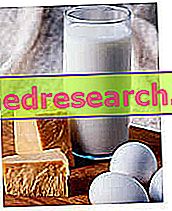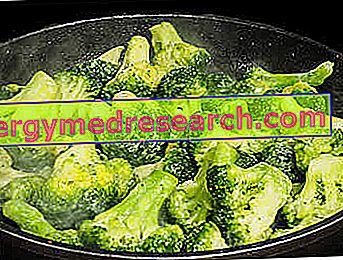Milk and Dairy in the Diet
Foods that contain lactose are:
- MILK, DAIRY PRODUCTS AND DERIVATIVES
- MILK MILK POWDER (preservative - thickener)
Lactose is a disaccharide glucide, or a dimer composed of two simple sugars, glucose and galactose respectively. Lactose is a unique carbohydrate, it comes from milk and its presence in food is a prerogative of those who (for one reason or another) derive it or contain it.

Milk is an INDISPENSABLE food ONLY in the phase of breastfeeding, therefore, evolution and individual subjectivity play an essential role in the ability to digest it or not. Mostly, the difficulty in digesting milk derives from an insufficiency (transient or permanent) of a specific enzyme for the breakdown of lactose: LACTASE. Lactase is a biological catalyst present on the brush border of enterocytes (cells of the intestine) which allows the glucose + galactose dimer to be cleaved and thus absorbed by the intestine. In the absence or deficiency of this enzyme, lactose is neither digested nor absorbed by the intestine; the consequent intestinal fermentation of lactose is responsible for the typical symptomatology of food intolerance. It is equally true that the ability to digest lactose also derives from the maintenance of enzymatic activity; therefore, in the long term, interrupting the intake could lead to a reduction in the tolerability of this sugar. For milk lovers, who have difficulty tolerating lactose, there are products called "delattosate", which artificially undergo hydrolysis of lactose for the benefit of the intolerant consumer.
It often happens that professionals and the uninitiated ask themselves:
- why continue to promote milk consumption if lactose intolerance is such a widespread condition ?
my answer (absolutely personal) is that:
- Milk, while containing lactose (an often non-digestible carbohydrate), is a food that provides a good quantity of essential nutrients; among these, we recall the high biological value proteins, riboflavin or vitamin B2 and calcium, not to mention that boasting 87% of water, milk favors the maintenance of a good state of hydration. In my opinion, this is a very useful food to reach some recommended rations; therefore, if well tolerated, I think it is a good habit to make use of it as long as it is proportionate to your food needs.
NB. A minor part of the adverse reactions related to the consumption of milk and its derivatives concerns allergy to its proteins.
There is a strong heterogeneity in the degree of tolerance and digestive capacity of lactose; these are mostly genetic and racial differences, therefore subjective and influenced by eating habits or certain intestinal pathologies. What is certain is that lactose is not a uniquely digestible nutrient; therefore its diffusion in food products should be limited or at least well marked.
Lactose in food
Milk contains lactose and the only way to neutralize it is through industrial hydrolysis; the lactose content in the various types of milk varies, albeit slightly, also based on the animal that produces it:
| Food | Lactose content per 100ml of edible part |
| Human milk | from 3.7 to 5.9g |
| Whole cow's milk | 4, 7g |
| Goat's milk | 4, 7g |
| Sheep's milk | 5.2 |
| Buffalo milk | 5, 1g |
| etc. |
The table shows that the lactose content in milk is almost ubiquitous among the various species; therefore, it can be deduced that the variability of the symptomatology between the different intolerant subjects depends above all on the portions and the level of lactase deficiency rather than on the type of milk consumed.
Dairy products, on the other hand, are all those foods that are derived from milk processing and still contain significant amounts of lactose, despite being subjected to industrial processes and / or bacterial fermentation:
| Food | Lactose content per 100ml of edible part |
| Cow's milk ricotta | 4.0g |
| Butter | 4.0g |
| Whole yogurt | 3, 2g |
| Fresh cream | 3, 2g |
| Milk flakes | 2, 8g |
| Cow's milk mozzarella | 1, 5-2g |
| Caprino | 1, 5-2g |
| Growth | 1, 5-2g |
| ...and many others |
We remind you that the simple classification between dairy products and non-dairy products does NOT guarantee the presence or absence of lactose from the product, but only the extent of its concentration.
- Furthermore, I believe it is important to underline that the MOST of sweet snacks, some baked goods (industrial and non-industrial), almost all pastry products (especially fresh but not only), and even some alcoholic beverages, on the label indicate the presence of milk or derivatives.
Food with skimmed milk powder
Skimmed milk powder is a food product often used as an additive ingredient; it is obtained by dehydration by heat (max 3.2% of water) and contains lactose up to 56% of the total weight. The low-fat milk is very common in the food industry, as it is a product capable of:
- Compact and solidify, drastically reducing the amount of free water by absorption; milk powder is able to bind 100% of its weight in raw foods and up to 120% in cooked foods
- Store due to free water reduction
- Limit the costs, because binding the water keeps the weight of the product high, which does not dehydrate, and because it represents in itself an economic additive. Furthermore, its addition to cooked products greatly limits the leakage of fat.
The addition of skimmed milk powder is allowed in proportions of 10% in raw sausages (such as salami) and 2-4% in cooked sausages (such as mortadella).
- Foods that contain lactose are many and are not always easy to spot; in case of intolerance, it is recommended to ALWAYS and ACCURATELY read the food label of all industrial products, paying particular attention to sausages, baked goods, pastry products and packaged snacks.



